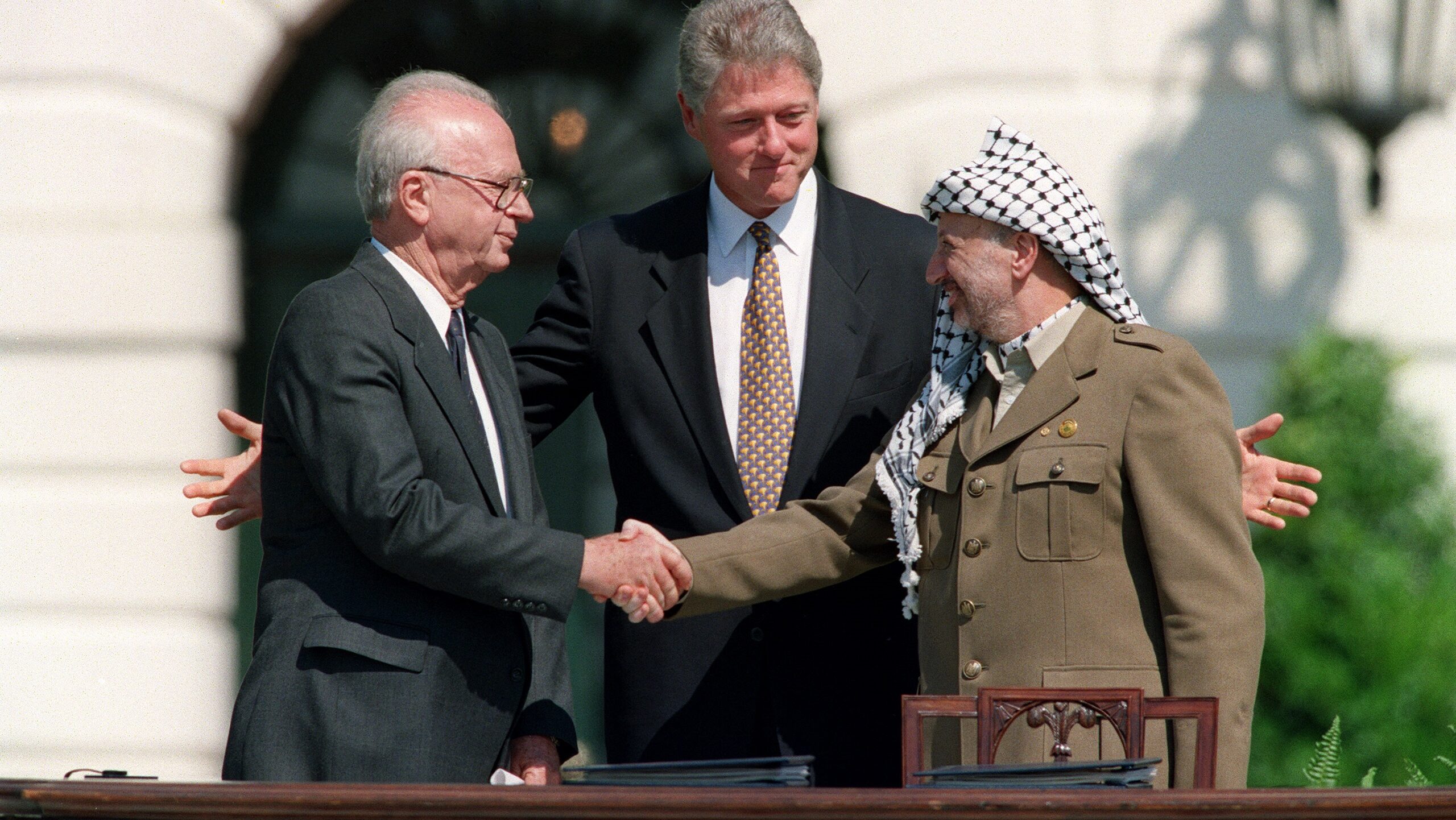The Oslo Accords: Not a Total Failure
The first Oslo Accord was signed 30 years ago this month between Israel and the PLO, and while it has not brought about the hoped-for peace, it has had some benefits, including saving hundreds, if not thousands, of Israeli lives
Sept. 13 marks 30 years since Israel and the Palestine Liberation Organization signed the first Oslo Accord, an interim agreement that was supposed to lead to a peaceful resolution to the Israel-Palestinian conflict.
It failed. Or did it?
It did not bring about a solution, with Israel living peacefully next to a state called Palestine. It is fashionable to blame both sides, and Israel did some negative things.
But the fact is that in the framework of peace negotiations in 2000 and again in 2008, Israel offered the Palestinians a state in the equivalent of all of the West Bank and Gaza Strip, with a corridor through Israel to connect them.
That was what the Palestinians said they wanted. Chief negotiator Saeb Erekat intoned over and over again, “All we want is 23% of historic Palestine,” referring to the British Mandate territory that included Israel, Jordan, the West Bank, and the Gaza Strip. However, the Palestinians rejected both offers, and their leaders, Yasser Arafat and then Mahmoud Abbas, stopped the negotiations.
So the Oslo Accords peace process reached its logical conclusion twice, with the second Oslo Accord signed in Taba, Egypt, in 1995.
But it didn’t bring peace. Clearly, that’s a failure. Instead, the three decades since the signing on the White House lawn in Washington have been marred by violence, with Palestinian terror attacks and Israeli military operations.
Instead of working for peace, Arafat set up a corrupt, incompetent, and violence-centric Palestinian Authority in Gaza and in about 40% of the West Bank, where more than 90% of the territory’s Palestinians live. In the meantime, the violent Islamist group Hamas took over Gaza, targeting Israel while making Palestinians’ lives miserable.
Since 1993, more than a thousand Israelis have been killed in Palestinian attacks. On the other hand, the Palestinian death toll is much higher than Israel’s. Palestinians suffer the daily humiliation and sanctions of Israeli occupation, as well as the frustration of living under a corrupt Palestinian regime that has been labeled with various epithets, including “kleptocracy.”
Unless you consider the establishment of a limited Palestinian government a success, there’s no pot of gold for the Palestinians at the end of this Oslo rainbow
Unless you consider the establishment of a limited Palestinian government a success, there’s no pot of gold for the Palestinians at the end of this Oslo rainbow.
You’d be hard-pressed to find Israelis who acknowledge that the Oslo process was beneficial for them either, considering the failure to bring peace and the violence that has since plagued both sides.
But Israelis are missing the obvious: When implementing an initial part of the Oslo agreement, Israel withdrew its forces from the main Palestinian population centers in the West Bank and Gaza.
That means Israeli soldiers are no longer posted inside Palestinian cities and towns. They no longer patrol the alleys of Nablus or the streets of Ramallah. They no longer have a base inside the huge, poor, and violent Jabalia refugee camp in Gaza.
The farther we get from the beginning of the process, the harder it is to acknowledge the significance of this change. Instead, myths abound, and even calls to return to the 18 settlements Israel evacuated in Gaza in 2005.
The settlers who were evacuated have faced hardships and trauma, partly as a result of their refusal to cooperate with the government in relocating them. But to paint their lives in Gaza before the pullout as quiet and peaceful is a distortion of reality at best and a politically motivated lie at worst.
Long before the pullout, Gaza settlers complained bitterly about their conditions, as Palestinian mortar shells and rockets rained down on them. I remember riding in a “bus” with settlers from the village of Netzarim in northern Gaza. The “bus” was a truck with thick cement walls. A conventional bus would have been an easy target for Palestinian gunfire or bombs.
The Israeli military tried to stop the attacks on the settlements with repeated operations and airstrikes but failed. They ended with the pullout from Gaza, but then the rockets were redirected toward Israel.
The West Bank is different only as a matter of degree. As a radio reporter, I spent several days a week in the West Bank in the days before Oslo. I watched Israeli soldiers as they patrolled the streets of Ramallah, Nablus, and refugee camps.
The hatred from the Palestinians and the nervousness of the young soldiers was apparent. Even though attacks drew quick and painful retaliation, Palestinians constantly targeted soldiers. Sixty soldiers were killed between 1987, when the first Palestinian uprising erupted, and 1993, when the Oslo I accord was signed.
A further 332 were killed in the second Palestinian uprising, from 2000 to 2008. Often Israeli soldiers were sent back into Palestinian population centers to try to tamp down deadly waves of attacks, including suicide bombings, which killed more than 700 Israeli civilians.
Then Israel retreated behind its security barrier, built roughly along the line between the West Bank and Israel after a major military operation in 2002. Israel let the Palestinian Authority, with all its faults, handle day-to-day security, with the help of Israeli intelligence and occasional military operations, which have been increasing in frequency in recent months.
That’s the background for this journey into counterfactual history. If there had been no Oslo Accords, there would be no security barrier. There would have been no withdrawal from Gaza City, Jabalia, Nablus, or Ramallah.
Without Oslo, Israeli soldiers would still be stationed in the most volatile, crowded hotbeds of violent Palestinian hatred. The soldiers would be easy targets for Palestinian snipers and bombers, just as they were in Gaza before the 2005 pullout.
It’s not unreasonable to conclude that in some weeks, 10 soldiers would be killed. Some weeks, “only” five.
There would be tearful, angry funerals practically every day. Israelis would demand retaliation. The army would be sent in to battle armed Palestinians, killing many but taking many casualties too.
More funerals, more tears, more anger. More military operations.
If we assess the actual security situation in the West Bank and Gaza Strip before and after Oslo, the main accomplishment is getting Israeli soldiers out of the main lines of fire in those areas
And what about the settlements? The ones in Gaza would be shelled constantly, and the settlements in the West Bank would become targets too. Infiltrations, gunfire; how long would it be until the same concrete Gaza “buses” would be used in the West Bank? Then what?
There’s no end to this without a political solution, and Oslo was the first attempt at that. The results are not all negative.
If we assess the actual security situation in the West Bank and Gaza Strip before and after Oslo, the main accomplishment is getting Israeli soldiers out of the main lines of fire in those areas. So Oslo has saved the lives of hundreds, perhaps thousands, of soldiers.
It’s not all Israelis hoped for, but it’s worth recognizing as positive.



